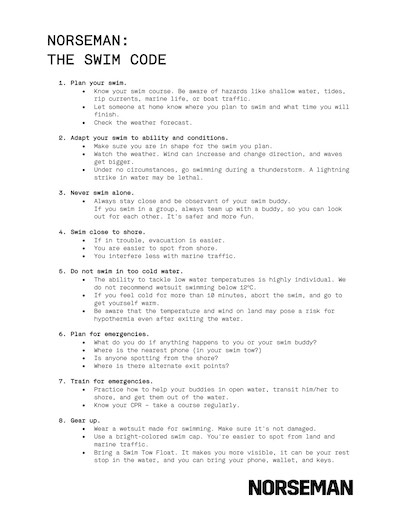1. Plan your swim.
- Know your swim course. Be aware of hazards like shallow water, tides, rip currents, marine life, or boat traffic.
- Let someone at home know where you plan to swim and what time you will finish.
- Check the weather forecast.
2. Adapt your swim to ability and conditions.
- Make sure you are in shape for the swim you plan.
- Watch the weather. Wind can increase and change direction, and waves get bigger.
- Under no circumstances, go swimming during a thunderstorm. A lightning strike in water may be lethal.
3. Never swim alone.
- Always stay close and be observant of your swim buddy.
- If you swim in a group, always team up with a buddy, so you can look out for each other. It’s safer and more fun.
4. Swim close to shore.
- If in trouble, evacuation is easier.
- You are easier to spot from shore.
- You interfere less with marine traffic.
5. Do not swim in too cold water.
- The ability to tackle low water temperatures is highly individual. We do not recommend wetsuit swimming below 12°C.
- If you feel cold for more than 10 minutes, abort the swim, and go to get yourself warm.
- Be aware that the temperature and wind on land may pose a risk for hypothermia even after exiting the water.
6. Plan for emergencies.
- What do you do if anything happens to you or your swim buddy?
- Where is the nearest phone (in your swim tow?)
- Is anyone spotting from the shore?
- Where are there alternate exit points?
7. Train for emergencies.
- Practice how to help your buddies in open water, transit him/her to shore, and get them out of the water.
- Know your CPR – take a course regularly.
8. Gear up.
- Wear a wetsuit made for swimming. Make sure it’s not damaged.
- Use a bright-colored swim cap. You’re easier to spot from land and marine traffic.
- Bring a Swim Tow Float. It makes you more visible, it can be your rest stop in the water, and you can bring your phone, wallet, and keys.

Print?
Do you want a printable version of The Swim Code, click here.


